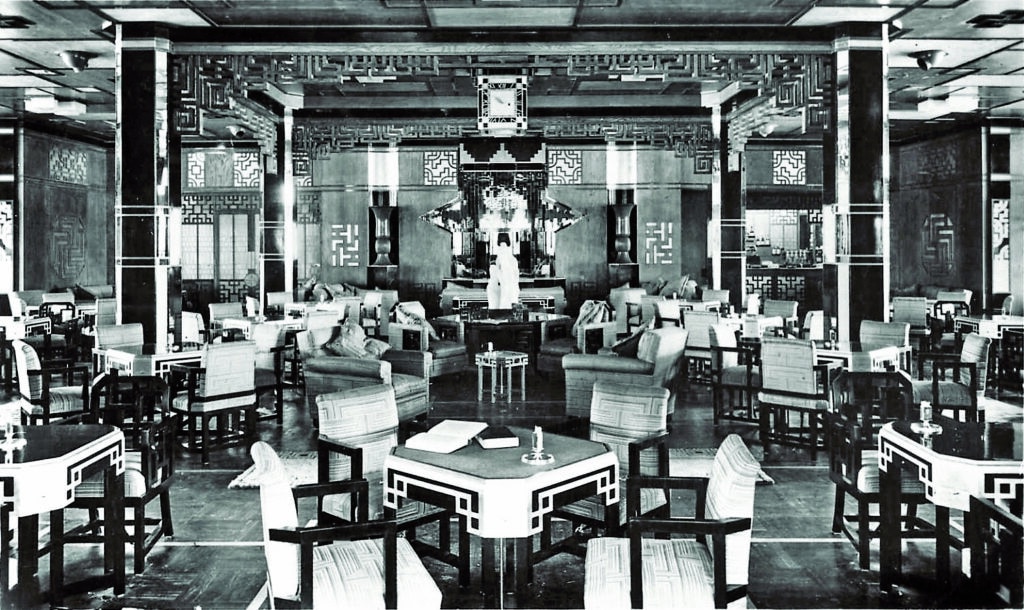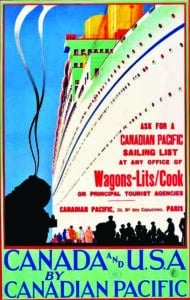By Bill Miller

Ocean liners were once described as the “greatest moving objects made by man.” They were also great symbols: They embodied size, might, and speed, but were also maritime temples, boasting the latest achievements in interior design. Some say the Art Deco liners were the very best, absolutely the most glamorous and memorable of all the great ships. There were six that stand out: the SS Ile de France, RMS Empress of Britain, SS Rex, SS Conte di Savoia, SS Normandie, and RMS Queen Mary. And the beloved Ile de France was just the beginning.
Innovation on the High Sea: Compagnie Générale Transatlantique
The SS France (1912) was extremely pleasing in almost every way, especially its stunning decor. Its first-class accommodations were so popular that it had the lowest number of vacant berths in first class of any Atlantic Ocean liner during the mid-1920s.
In the wake of the great success of the France, the Compagnie Générale Transatlantique (known as the French Line in the U.S.) began construction on the new SS Paris in 1913, which was due in 1916. However, construction came to a halt because of the First World War, and the Paris finally emerged in the summer of 1921.
The Paris was highly innovative––it differed from the heavily gilded, Edwardian styles of the earlier France, by introducing a new, more contemporary look––Art Nouveau on the high seas. Some say that the designers of the Paris actually introduced the very first, authentic ocean liner style. (Others attribute this to the next French liner, the Art Deco Ile de France.) The designers of the Paris broke from the trend of copying landside structures such as manor houses and country homes, chalets, and hunting lodges, and instead used a newly created decorative style. It was a sensation, but after a serious dockside fire at Le Havre in August 1929, the Paris was repaired and at the same time modernized: much of the Art Nouveau was removed and was replaced by even more modern, Ile-inspired Art Deco. The Paris became more popular than ever and an even better companion to the slightly larger, immensely popular Ile de France.
While moderately sized liners seemed to be more in vogue in the 1920s and more cost-effective, the French opted next for a larger, grander, more sumptuous version of the Paris. The 43,000-ton Ile de France was commissioned in 1927 and immediately captured the imagination of the world. Innovative, trendsetting, luxurious, and featuring the finest kitchens afloat, it was, in many ways, the most successful, most adored of all French liners.
The accommodations aboard the 791-foot-long Ile de France were divided into three classes—first class, cabin class, and third class. All cabins, even in lower deck third class, offered beds instead of bunks. The first class quarters were exceptionally lavish and included a large assortment of suites and cabins de luxe. It was said to offer the finest selection of suites on the Atlantic. By 1935, the Ile de France had carried more first class passengers than any other transatlantic liner.
But it was the overall style and extraordinary decor that fascinated both travelers and competitors of the French Line. Inspired by the influential Exposition Internationale des Arts Décoratifs et Industriels Modernes held in Paris in 1925, the Ile’s interiors marked the beginning of Art Deco on the high seas. It was the new modern and the immediate standard of ocean liner decor and style. The new design style could also be seen in office buildings, hotels, railway terminals, movie theaters, and department stores. The designers of the Ile de France introduced the sleek new age of angular furniture, sweeping columns and panels, inventive and indirect lighting, and a great sense of spaciousness that all but eliminated the heavy clutter of prior ocean liners. The first class bar was the largest afloat and the main restaurant, compared to a modern Greek temple, rose three decks in height. It had a grand staircase as the main entrance, another feature that became a French Line trademark. The main foyer rose three decks high, and the chapel was designed in a Gothic-inspired style with fourteen pillars. Indeed, a floating city, the 1,786-passenger Ile also had a shooting gallery, merry-go-round, and a fully equipped gymnasium.
From the beginning of her days, the Ile always had a great reputation,” recalled the late Lewis Gordon, a veteran of over 100 Atlantic crossings. “She was said to be the happiest and cheeriest way to cross the Atlantic. And, of course, she had great glamour. More celebrities—royalty, politicians, and especially Hollywood stars—preferred her. The Ile always, always had a distinct tone of chic, that very special French chic, about her!”
Dual Purpose: An Empress of the Seas


The North Atlantic run to Eastern Canada warranted many more small and medium-sized passenger ships than the route to New York, but only one super liner: the Empress of Britain of Canadian Pacific Steamships, which was commissioned in 1931. Capped by three oversized funnels and with an all-white hull, it was the grandest, largest, and fastest liner ever to sail on the Canadian route between Southampton and Quebec City. In winter, the ship served an alternate purpose: four-month-long, luxury cruises around the world. The Empress also had superb accommodations: columned lounges, a Grecian-inspired main lounge, luxurious suites and staterooms, and the very first large tennis court on its top decks. The ceiling of one of its many bars depicted the history of the cocktail while the Cathay Lounge was designed in Chinoise Moderne, or what we might now call “Shanghai Deco.”
On the Sunny Southern Route: Italy’s Rivieras Afloat
Mussolini and his Fascist ministers wanted their share of the ocean liner business and created two superliners, the Rex and the Conte di Savoia, in 1932. They were both Art Deco super ships of the early 1930s and together would offer the first big ship service on the Mid-Atlantic, to and from Mediterranean ports (Naples, Genoa, Villefranche-sur-Mer, and Gibraltar).
Both the Rex and the Conte di Savoia had lavish lounges, superb dining, and the first outdoor pools aboard superliners. With striped umbrellas and real sand covering the decks, this outdoor pool area was called the “Lido Deck.” This novelty deck and the ships themselves were often described as the Rivieras afloat.
Ocean-Going Perfection: The Extraordinary Normandie

France’s Normandie was the most glamorous and superbly decorated Atlantic superliner. Its exceptional $60 million cost ($1.2 billion in 2021 dollars), heavily underwritten by the French government, also made it the most costly liner of its time. It was planned as the largest, fastest, and grandest ship, but also as a showcase for “the genius of France,” according to the French Line’s publicity department. The ship was a floating ambassador, a grand flag-waver, but also a floating hotel and even a floating museum.
The very finest designers and decorators in France would contribute to this maritime tour de force. However, Vladimir Yourkevitch, a former designer of Imperial Russian battleships, was placed in charge of the project, creating the advanced overall design and exterior. The Normandie was exceptional in every way: the first liner to exceed 75,000 tons and the first to surpass one thousand feet in length. Names such as Neptune, General Pershing, Le Belle France, Napoleon, Jeanne d’Arc, and even Maurice Chevalier were suggested before Normandie was finally selected. Launched at Saint-Nazaire in western France in October 1932, the ship already had experienced a tragic event: one hundred workmen were swept into the Loire at launching.
With its construction halted for a time due to the Great Depression, it was finally completed and entered service between Le Havre, Southampton, and New York in May 1935. The maiden voyage broke all transatlantic records: thirty-two knots at full speed and with a passage of four days and three hours.

On board, the Normandie was beyond impressive and certainly wondrous. The ship was an Art Deco paradise, a floating fantasyland of 1930s decor. The main restaurant, decorated in bronze, hammered glass, and Lalique fixtures, was longer than the Hall of Mirrors at Versailles, sat one thousand guests, and offered some three hundred items on the dinner menu. The bronze doors outside led to a vestibule lined with Algerian onyx. There was an indoor, one-hundred-foot pool of tiered, lighted levels and a winter garden complete with fresh greenery and live birds. There was a chapel, the first movie theater at sea, an extensive library, a grill room, various salons, and the very finest suites and penthouses on the Atlantic. The penthouses even had their own music rooms and private dining salons. In first class, no two cabins were alike – including one decorated in Louis XIV and another in red lacquer. Even the dog kennel had its own sun deck. There was a florist, chocolate shop, and tailor onboard who could prepare a man’s suit within the crossing period. The Normandie was indeed a floating city.

The bedroom of the Rouen Suite aboard the Normandie
In 1938, there were plans to build a super Normandie, another advanced design but bigger still, of some 90,000 tons and dubbed Bretagne. Plans were scrapped because of cost, but mostly out of concern for the looming war in Europe. The Normandie was a great success for the image of France but was not an economic success. In its four years of service, the Normandie sailed at only 59% capacity; many travelers did not have the means for such luxurious travel. With the exception of the Queen Mary, all of the large, new superliners of the 1930s were less than economically successful. The Empress of Britain was simply too big for the Canadian run and the mid-Atlantic service to the Mediterranean for the Rex and the Conte di Savoia had yet to fully catch on.
The exquisite Normandie was docked in August 1939 at New York, owing to the uncertainty of the political situation in Europe, never to sail again. The ship caught fire at its berth at West 48th Street in February 1942, then capsized, was later salvaged, and the remains were finally demolished in 1947.
Pride and Profit: The Glorious Queen Mary

The 81,000-ton Queen Mary came into service in the spring of 1936 and was immediately the greatest rival to France’s Normandie. While the French flagship was more innovative and certainly more lavish, Britain’s Queen Mary was in contrast a great financial success, sailing in its first years at 98% of capacity.
“The Normandie was the most extravagant, luxurious, and celebrated liner of her time,” said the late maritime historian Everett Viez. “But the Normandie was most likely too luxurious, too Art Deco extravagant. Comparatively, the Queen Mary was less glamorous, possibly less stunning, and certainly less pretentious. She too was a Deco liner, but British Deco. She was welcoming, warm, and a classic British liner: comfortable and even cozy in places, decorated in polished woods, swirl carpets, sconce lamps, soft chairs, and lots of linoleum floors. While the decor of the Queen Mary was once described as ‘Odeon cinema,’ it greatly appealed to the ocean traveling public. While the Normandie was Champagne and caviar at midnight, the Queen Mary was tea and cakes at four in the afternoon.”

The Queen Mary also had, by far, the longest career. It sailed for the Cunard Line for thirty-one years, until 1967, and crossed the Atlantic one thousand times. Afterward, the ship found life as a hotel, museum, and collection of shops and restaurants moored in Los Angeles harbor to this day.
There were, of course, many other Art Deco liners. Holland’s MS Nieuw Amsterdam, commissioned in 1938, had splendid interiors. Flying the British flag, the RMS Orion of 1935 introduced Art Deco on a route east of Suez: From London to Sydney. And three American liners–the SS Panama, SS Ancon, and SS Cristobal, each built in 1939, and used in New York-Caribbean service, made great use of stainless, sleek, armless chairs, and touches such as clock dials without numbers.
Without question, Art Deco on the high seas was high style. The late maritime historian, Frank Braynard, once noted, “Deco liners were like the Waldorf Astoria except they moved!”
CREDIT: This article originally appeared in the Art Deco Society of New York’s June 2018 issue of the Art Deco New York Journal. For more information on the Art Deco Society of New York and its journal, visit www.ArtDeco.org/journal
AUTHOR BIO: Bill Miller is considered an international authority on the subject of ocean liners. Called “Mr. Ocean Liner,” he has written over 100 books on the subject: from early steamers, immigrant ships, and liners at war to other titles on their fabulous interiors in postcard form, and about their highly collectible artifacts. He has written histories of such celebrated passenger ships as the United States, Queen Mary, Rotterdam, France, Queen Elizabeth 2, Costa Victoria, Super Star Leo, and Crystal Serenity.




Related posts: